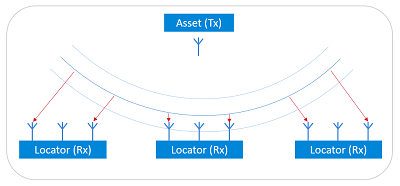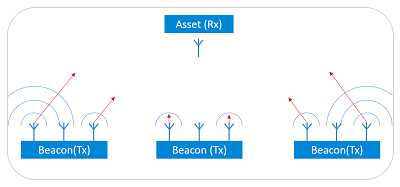Direction Finding Methods#
Two methods for Direction Finding exist. In one method an Asset (to be located) transmits a signal and the Locators receive this signal. The Locators then are able to determine the relative direction of the asset. This is called the Angle of Arrival (AoA) calculation. In the other method, the Asset (to be located) receives the signal transmitted by some Beacons. In this case the Asset is able to determine its relative direction to the Beacons. This is called the Angle of Departure (AoD) calculation.
The first method can be used when an asset is to be found in a big warehouse, for example. The second method is useful if the Asset wants to locate itself without anyone else knowing its location. For example, a shopper wants to determine their position in a big shopping mall using their smartphone and the signal of some beacons. That individual definitely does not want to transmit signals to let others know where they are.
Angle of Arrival (AoA)#
The complicated theory of Direction Finding can be simplified to the following fact: if multiple receiver antennas are placed next to each other, the radio waves emitted by a single transmitter will reach the different antennas in different phases. From this phase difference the direction the radio waves came from can be calculated. Since the angle is determined relative to the receiver, this use case is called Angle of Arrival estimation.


Assuming that the incoming signal does not change frequency during measurement (that is, it is unmodulated), and that the distance between the receiver antennas is shorter than half of the wavelength, the phase difference unequivocally determines the angle of incidence.
In this method:
The Asset transmits an unmodulated narrowband signal for a specific time.
The Locator samples the received signal on multiple antennas.
In practice, the receiver must have multiple ADC channels or use an RF switch to take samples from each individual channel. The samples are called “IQ-samples” since a sample pair of “In-phase” and “Quadrature-phase” readings are taken from the same input signal. These samples have a 90-degree phase difference in the sampling. When this pair is considered to be a complex value, each complex value contains both phase and amplitude information and can be an input for the arrival angle estimation algorithm.
Radio waves travel at the speed of light, which is 300,000 km/s. At frequencies around 2.4GHz, the corresponding wavelengths are about 0.125 m. The maximum distance between two adjacent antennas for most estimation algorithms is a half wavelength. Many algorithms require this, otherwise effects similar to aliasing occur. There is no theoretical minimum distance limitation, but in practice the minimum size is limited by the mechanical dimensions of the array plus, for example, mutual coupling between the antenna elements.
Angle of Departure (AoD)#
The setup can also be reversed. If multiple antennas transmit waves with the same initial phase, then a single antenna can measure the phase differences of the different incoming waves and it can calculate its own direction relative to the transmitting antenna array. Since the angle is now determined relative to the transmitter, this use case is called Angle of Departure estimation.


Note that transmitters (Beacons) have to transmit with the same frequency on each antenna, because that is a prerequisite for the angle calculation. This also means that the antennas cannot transmit at the same time, since their signals would interfere. To solve this issue, the transmitter device must sequentially switch between the transmitting antennas, and the receiving side must know the antenna array configuration and switching sequence.
In this method:
The Beacon transmits an unmodulated signal on multiple antennas using time division, that is, only one antenna transmits at a time.
The Asset (for example a smartphone) samples the signal of the multiple antennas using the same time division.
From the application’s perspective, the two methods are clearly different. In AoD, the receiving device is able to calculate its own position in space using angles from multiple beacons and their positions (by triangulation). In AoA, the receiving device tracks arrival angles for individual objects. However, because the two methods can be combined in different ways, the methods do not limit what can be done at the application level. In both Bluetooth AoA and AoD, the related control data is sent over a traditional data channel. Typically, these techniques can achieve a couple of degrees angular accuracy and around 0.5 m positioning accuracy, but these figures are highly dependent on the implementation of the positioning system.
